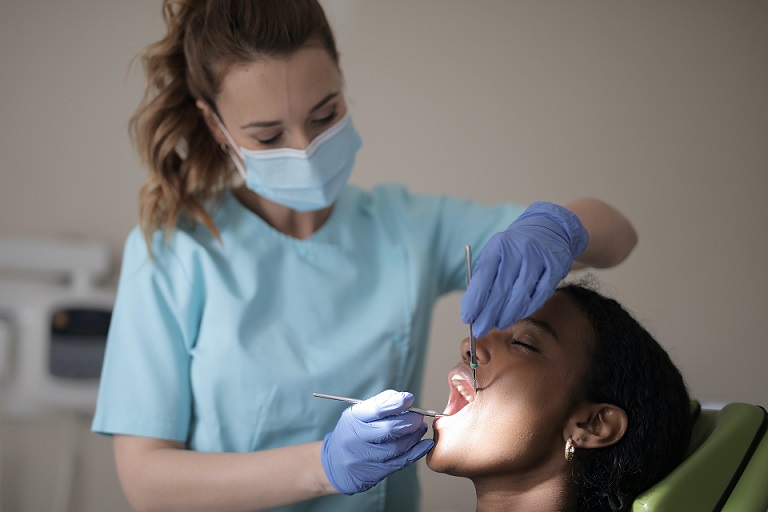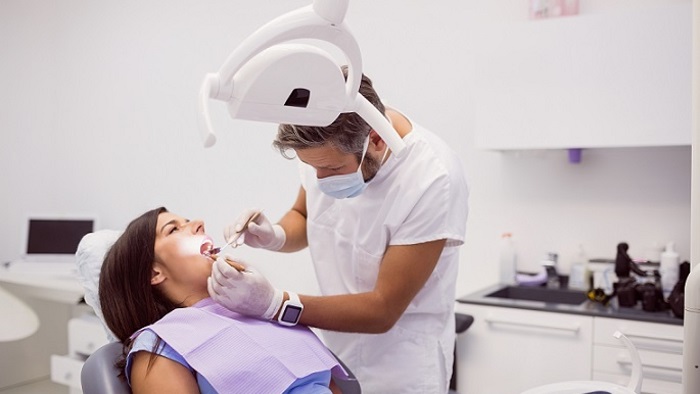Understand The Role Of Dental Assistants
Dental assistants get things ready for dental checkups and treatments. When you visit the dentist, they’re usually the first people you meet. Their job includes:
- Performing Clinical Tasks: Dental assistants assist dentists during procedures by preparing treatment rooms, sterilizing equipment, and handling instruments. They also take X-rays, make dental impressions, and perform tasks directed by the dentist.
- Handling Administrative Responsibilities: They schedule appointments, manage patient records, handle billing, greet patients, answer calls, and coordinate with other healthcare providers.
- Educating Patients: Dental assistants take on the responsibility of educating patients about proper oral hygiene practices, including effective brushing and flossing techniques. They also provide information about dental procedures, alleviating patient concerns and fears.

- Ensuring Infection Control: They maintain a clean environment by sterilizing equipment, following infection control rules, and disposing of materials properly.
- Conducting Laboratory Duties: In addition to clinical work, dental assistants may perform various laboratory tasks, such as pouring and trimming models, creating temporary crowns, fabricating dentures, and managing the maintenance and repair of dental equipment.
- Team Collaboration: They collaborate with dentists and the dental team, ensuring smooth operations by offering support and effective communication.
- Patient Comfort: Dental assistants ensure patient comfort during procedures by providing blankets, encouragement, and managing pain with anesthesia or nitrous oxide.
Exam Requirements for Dental Assistant Program
Dental assistant training depends on state licensing and certification preferences. Some individuals choose to go for vocational high school programs, though additional training may be needed based on state regulations.
Certain states necessitate a certification exam post-training, while others rely on on-the-job training (OJT) for dental assistant roles. You can consult the Dental Assisting National Board (DANB) guide to determine your state’s licensing requirements.
For states requiring certification, choose a training program accredited by the American Dental Association’s (ADA) Commission on Dental Accreditation (CODA). CODA accreditation indicates adherence to top-tier professional and ethical standards, recognized by the Dental Assisting National Board for certification.
Steps to become a Dental Assistant
Complete a Dental Assistant Program
Look for programs accredited by the Commission on Dental Accreditation. They’re often offered at vocational schools or community colleges. You’ll need at least a high school diploma or GED. Programs usually take one to two years for a certificate or associate degree. Coursework covers teeth, gums, dental tools, CPR, and related subjects. Consider an externship to explore specialties like orthodontics or restorative care.
Certification and Licensing
After completing your education, seek a state license to work as a dental assistant. Check requirements from your state’s dental board or the Dental Assisting National Board (DANB). Some states may require a Certified Dental Assistant (CDA) exam covering general chairside assisting, radiation health, and infection control.
For specialization, consider additional certifications like National Entry Level Dental Assistant (NELDA), Certified Orthodontic Assistant (COA), Certified Preventive Functions Dental Assistant (CPFDA), Certified Restorative Functions Dental Assistant (CRFDA), or Registered Dental Assistant (RDA) based on your interest.
Find a Job
Apply for entry-level dental assistant positions, emphasizing your education and any externship or volunteer experiences. Create a resume highlighting your familiarity with the dental environment, tools, patient interactions, and workflows.
Consider Further Education
After gaining some experience, think about pursuing a bachelor’s degree in dental hygiene. This advanced degree can lead to better pay or promotions. You can often transfer credits earned during your dental assistant education towards a dental hygiene or related degree.
Career Outlook and Options for Dental Assistants
| Position | Average Salary | Primary Duties |
| Orthodontic Assistant | $50,576 per year | Support orthodontists in dental procedures, prepare clients for surgery, maintain infection control, and handle administrative tasks. |
| Dental Receptionist | $54,990 per year | Greet and welcome patients, answer inquiries, manage appointments and accounts, and provide information on dental treatments and services. |
| Dental Assistant | $55,559 per year | Provide chair-side nursing, process and sterilize instruments, support dentists in various procedures, and occasionally handle reception and admin duties. |
| Sterilisation Technician | $56,828 per year | Prevent transmission of infection by preparing, sterilizing, and storing reusable dental equipment. Inspect, disassemble, reassemble, and pack equipment. |
| Dental Technician | $61,977 per year | Create and repair artificial teeth, use digital manufacturing devices, work with materials like wire and acrylic, and employ thermoforming techniques. |
| Dental Sales Consultant | $66,066 per year | Utilize dental assistant knowledge in sales, provide customer service, conduct patient consultations, handle payments, and maintain sales administration. |
| Dental Hygienist | $92,830 per year | Deliver preventative dental treatments, manage oral health, use diagnostic equipment, and maintain accurate patient records. |
| Treatment Coordinator | $70,451 per year | Assist in closing treatment plans, communicate with patients, organize documents, collect payments, and follow up with patients post-procedure. |
| Trainer/Assessor of Dental Courses | $86,300 per year | Deliver knowledge to students studying dental assistant courses, assist with curriculum development, plan lessons, organize practical development, and assess. |
| Dentist | $132,635 per year | Conduct oral examinations, identify diseases, clean teeth, apply prosthetics, and offer referrals. Expand dental assistant knowledge for a career as a dentist. |
How Long Does It Take To Become A Dental Assistant?- Time And Cost
| Education Type | Duration | Outcome | Cost |
| On-the-job Training | Several days to weeks | No certificate | Free or paid |
| Online Program | 3 to 12 months | Certificate | $1,000 to $10,000 |
| Community College Certification | 12 to 24 months | Certificate | $3,000 to $7,000 |
| Community College Associate Degree | 18 to 24 months | Certificate and Associate Degree | $5,000 to $40,000 |
Conclusion



